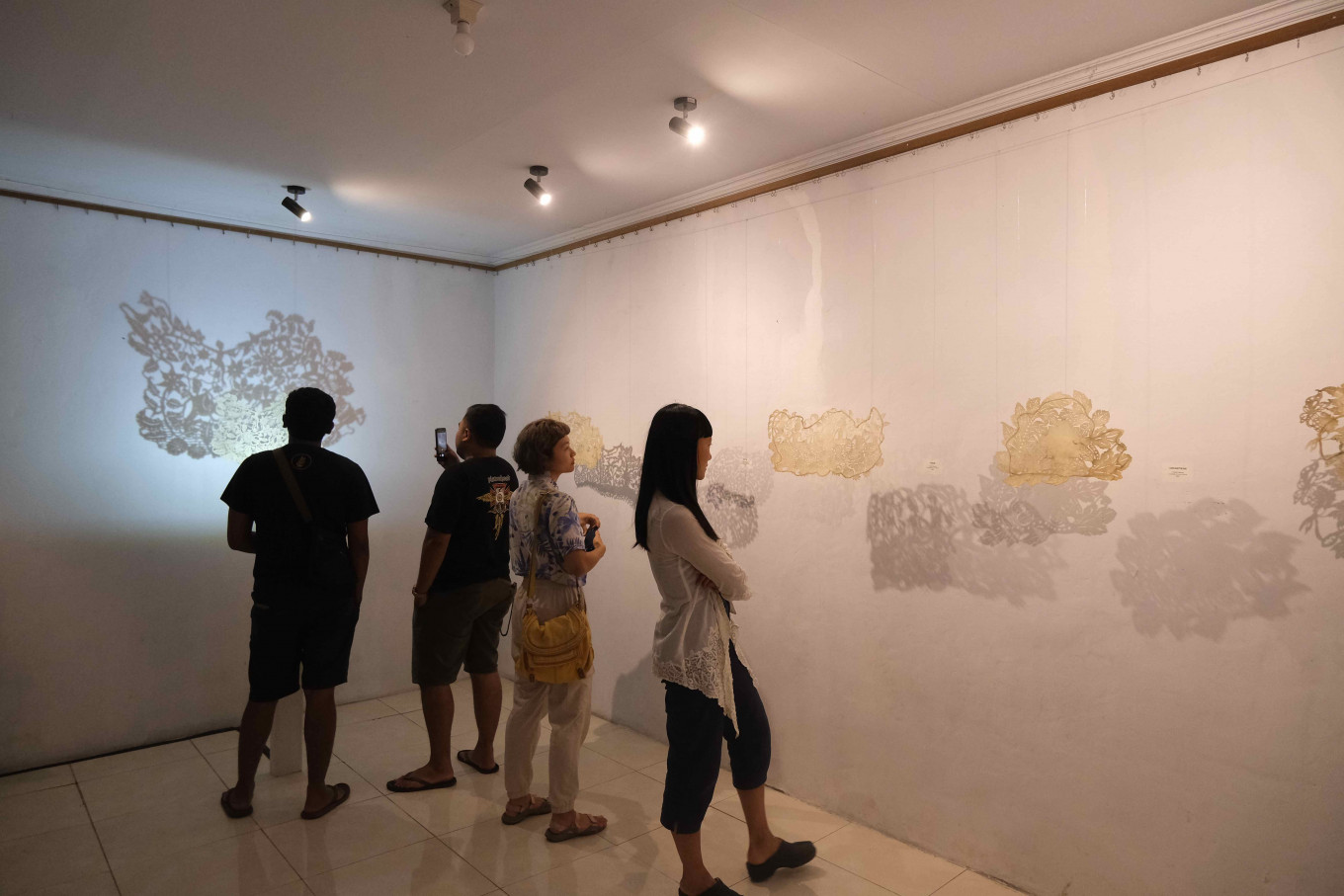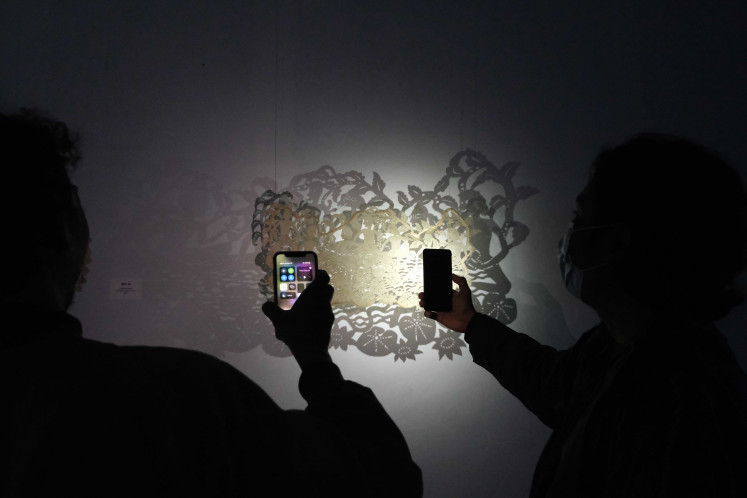Popular Reads
Top Results
Can't find what you're looking for?
View all search resultsPopular Reads
Top Results
Can't find what you're looking for?
View all search resultsEmerging Balinese artist Gede Sukarya reinvigorates an ancient medium
Gede Sukarya has a natural affinity with cows, a highly revered animal in his culture and village of Bulian, North Bali. His exploration into the potential of cowhide, outside of the iconic traditional conventions, realizes new possibilities in contemporary art expressions.
Change text size
Gift Premium Articles
to Anyone
G
ede Sukarya has a natural affinity with cows, a highly revered animal in his culture and village of Bulian, North Bali. His exploration into the potential of cowhide, outside of the iconic traditional conventions, realizes new possibilities in contemporary art expressions.
Belulang (cowhide in Balinese), upholds a distinction as an essential element in Balinese Hindu religious rituals. Leather-based ceremonial items are common, the Wayang Kulit shadow theater being one of the most well-known rituals still practiced today. Belulang is transformed into highly-decorative features of barong (lion-like creature and character in Balinese mythology) and topeng (colorful mask) performance pieces and headdresses. The hide contains a philosophical dimension, honored with spiritual values. The skin is processed untanned according to strict methods to maintain its sacred integrity.
Born in 1995 in Bulian, Buleleng regency, Bali, Sukarya’s village adheres to an unusual, old custom. Aci Bulu Geles is a sacrificial ceremony for ancestors involving cows in which each village boy must participate. Having grown up with a close association with the domesticated animals, Sukarya discovered an intuitive calling to investigate belulang as an artistic medium.
The outcome of the May 2022 artist-in-residency program, Rasidency, by Sukarya was recently exhibited at Gelombang Studio, Batuan. SKIN & SHADOWS: A Visual Study of Buleleng Ornament Style, which closed on July 31, featured nine works with flora, fauna and figurative motifs in an expressive style he is pioneering in the medium.
Spotlighted to emphasize the silhouettes, the works showcased Sukarya's ability to achieve intricacy of form, which set ablaze the reflected shadows. Especially potent was the interaction between the negative and positive spaces within his compositions. Also exhibited were an array of drawings and monochrome prints.
A collaboration between the Gurat Art Project, an initiative of the independent Balinese cultural research group Gurat Institute, and Ruang Antara Studio, Rasidency is a significant new addition to the Bali art infrastructure. The program offers Balinese artists the opportunity to develop their ideas through literature, fieldwork studies and organized and casual discussions over one month, culminating in an exhibition of their work.
“My introduction to working with cowhide came in 2018 from a friend’s father who is a traditional leather carver. However, I found it difficult and tiring, especially on my eyes and neck, because the carvings are small,” Sukarya told The Jakarta Post.
“I stopped temporarily, then began working again with greater commitment with another puppet artist in Denpasar.
"While studying for my bachelor's degree in Fine Arts at the Indonesian Art Institute [ISI] in Denpasar, I began an internship program focusing on belulang. I went on to select the material as the artistic object of my final project assessment at ISI in 2019," he stated.
Sukarya had early on displayed artistic talent in elementary school and continued to develop his skills and ideas by exploring cultural norms through painting at the High School of Visual Arts in Sukawati.
"One of my objectives during Rasidency was to uncover deeper aspects of my artistic identity. Therefore, I was compelled to investigate the traditional stone carving styles of north Bali, known as blelengan, which are unique to the regency."
Within the Gurat Institute's archives, Sukarya was able to reference Nglesir Visual, a 2009 documentation of architecture and sculpture in the blelengan style.
“My fieldwork took me to temples in Buleleng and my village to observe and sketch the carving style. The blelengan style is characterized by what the artists see around them in nature.”
In comparison, the carving styles of southern Bali are defined by patra, cultural guidelines describing how ornamental patterns of flowers and leaves may be expressed.
“Blelengan avoids symmetrical compositions and allows the carvers to accentuate the abundant floral motifs with larger leaf sizes and other associated patterns of the vines. The artist’s individuality may shine through,” Sukarya explained.
“The Rasidency program evolved responding to the artists wishing to explore and develop their ideas together in the spirit of collaboration with the Gurat Institute,” a researcher from the Gurat Institute, Vincent Chandra, stated.
“There is no strict format. The artists work in the Gurat headquarters at Ruang Antara Studio, Batubulan. They are supported to enrich their ideas through our archives, network, research excursions and human resources. Gurat’s goal is to set them on the correct path.”
Art enthusiasts: Exhibition attendees use flashlights from their handphones to accentuate the cowhide carving by Gede Sukarya. (Courtesy of Gurat Institute) (Courtesy of Gurat Institute/Courtesy of Gurat Institute)Sukarya’s technical process requires patience and skill. The composition is first sketched upon the medium, then using a hammer and pangotok (chisel), the hide is incised. A single work may take from one to two days to complete.
“Cowhide’s character differs from other media in terms of texture and natural color. It is a testing medium to process into a work of art. The high price of leather is also a challenge, so I often use the leftovers given to me by craftsmen. Sitting for long periods carving impacts my body causing fatigue,” he adds.
"The residency's greatest benefit to me was the introduction of research into my creative process. Previously I worked in the studio without applying a depth of thematic content into the work, only possible through investigation. This process will influence and improve my future work. The interaction and feedback with other artists and friends during the program were also valuable."
The Gurat Institute began in 2014, researching and archiving Balinese art and culture and has progressed, becoming increasingly interactive while helping to bridge gaps in the local art infrastructure. Rasidency helps unearth new possibilities within Balinese contemporary art expression. Sukarya's creative exploration opens the door for others to further experiment with traditional mediums and fresh and culturally relevant thematic content.













